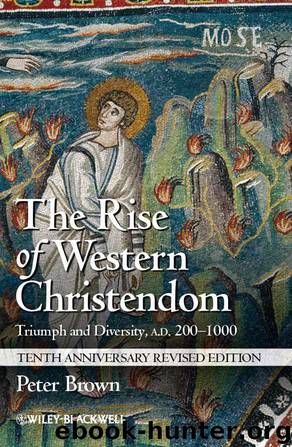The Rise of Western Christendom: Triumph and Diversity, A.D. 200-1000 (Making of Europe) by Brown Peter

Author:Brown, Peter [Brown, Peter]
Language: eng
Format: epub
Publisher: Wiley
Published: 2012-12-18T00:00:00+00:00
An Empire Gains its Public Face: Language, Coinage, and Mosques
As a result of these pressures, the state set in order by the successors of Mu’awiya, notably by the Califs ‘Abd al-Malik (685–705) and al-Walid (705–715), was a defiantly Islamic, Arabic state.
On the ground level, administrative practice continued as before. East Roman families continued to collect the taxes in Syria and Egypt, Persians did the same in Mesopotamia and Iran. Seen from below, little had changed. But this was not the case at the top. At the governmental level, the empire took on a firm, public face. After 699, Arabic became the sole official language of the bureauracy. At the time, the change affected only those involved in the business of administration. But the Califs also used the same, overwhelmingly visual means for making their presence felt in the world at large as had been used by the East Roman emperors. They used coins which everyone saw. After many experiments, a new gold and silver coinage was issued in 693 to replace the coins of East Rome, which had previously circulated as legal tender, or had been copied, with adaptations, in the Calif’s mints. Now the coins were cleared of all representations of the human figure. Only passages from the Qur’ân, in a firm Arabic script, could be seen on them.14 Even the milestones came to bear Arabic inscriptions, including the Muslim confession of faith, the shahâda: “I confess that there is no God but the One God, and that Muhammad is his prophet.”15
By the year 700, the public spaces of Syria, Egypt, and Iraq had begun to look distinctively Muslim and Arabic. Arabic could be seen on coins, inscriptions, and textiles. A little later, under the Calif Yazid II (720–724) the Cross (which had been the sign par excellence – almost the “national flag” – of the East Roman Christian empire founded by Constantine) was removed from public places.16
Above all, Muslims seized on the traditions of public building which had led, in East Rome, to stupendous monuments such as Constantine’s church of the Holy Sepulcher in Jerusalem and Justinian’s Hagia Sophia in Constantinople, as we saw in chapters 3 and 7. They were fully conscious of the need to compete with Christians. It was in this spirit that the Calif al-Walid built the Great Mosque in Damascus:
For he beheld Syria to be a country that had long been occupied by Christians and he noted the beautiful churches still belonging to them, so enchantingly fair and so renowned for their splendor [such as the church of the Holy Sepulcher in Jerusalem] … So he sought to build for the Muslims a mosque that should prevent them from looking with admiration at the Christian churches, and that should be unique and a wonder to the world.17
The Great Mosque of Damascus, which al-Walid began in 705, revealed very clearly what the Muslim rulers of the empire wished. They followed, in a new idiom, a thoroughly Roman ideal. They created public spaces in which to make stunning visual statements of the prosperity and innate superiority of their empire.
Download
This site does not store any files on its server. We only index and link to content provided by other sites. Please contact the content providers to delete copyright contents if any and email us, we'll remove relevant links or contents immediately.
The Gnostic Gospels by Pagels Elaine(2450)
Jesus by Paul Johnson(2284)
Devil, The by Almond Philip C(2255)
The Nativity by Geza Vermes(2158)
The Psychedelic Gospels: The Secret History of Hallucinogens in Christianity by Jerry B. Brown(2106)
Forensics by Val McDermid(2022)
Going Clear: Scientology, Hollywood, and the Prison of Belief by Lawrence Wright(1922)
Going Clear by Lawrence Wright(1908)
Barking to the Choir by Gregory Boyle(1759)
Old Testament History by John H. Sailhamer(1751)
Augustine: Conversions to Confessions by Robin Lane Fox(1722)
The Early Centuries - Byzantium 01 by John Julius Norwich(1684)
A History of the Franks by Gregory of Tours(1660)
A Prophet with Honor by William C. Martin(1659)
Dark Mysteries of the Vatican by H. Paul Jeffers(1654)
The Bible Doesn't Say That by Dr. Joel M. Hoffman(1633)
by Christianity & Islam(1584)
The First Crusade by Thomas Asbridge(1562)
The Amish by Steven M. Nolt(1517)
